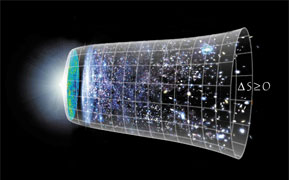 Date: Saturday, Oct. 20, 2007
Date: Saturday, Oct. 20, 2007
Time: 10:00 AM – 1:30 PM
Speakers: Prof. Lawrence M. Krauss and Prof. Fred Adams
Location: The Chicago Academy of Sciences – Notebaert Nature Museum 2430 N. Cannon Drive, Chicago, IL 60614
773-775-5100
Admission: Free to the Public
Click here for Brochure Cover, Inside
INTO THE DARK: The Future History of the Universe
Professor Fred Adams – University of Michigan, Ann Arbor
This talk outlines the long term fate of the cosmos. We consider the evolution of planets, stars, galaxies, and the universe itself over time scales that greatly exceed the current age of the universe. This discussion starts with new stellar evolution calculations that follow the development of the low mass (M type) stars that dominate the stellar IMF. We then determine the final mass distribution of stellar remnants – the neutron stars, white dwarfs, and brown dwarfs remaining at the end of stellar evolution. After several trillion years, the supply of interstellar gas grows depleted, yet star formation continues at a highly attenuated rate through brown dwarf collisions. This process tails off as the galaxy gradually loses its stars by ejecting the majority, and driving a minority toward accretion onto massive black holes. As the galaxy disperses, weakly interacting dark matter particles are accreted by white dwarfs, where they subsequently annihilate and keep the old stellar remnants relatively “warm”. After accounting for the destruction of the galaxy, we consider the fate of expelled degenerate objects (planets, white dwarfs, and neutron stars) within the assumption that proton decay is a viable process. The evolution and eventual sublimation of these objects is dictated by the decay of their constituent nucleons; this scenario is developed in some detail. After white dwarfs and neutron stars have disappeared, the black holes slowly lose their mass as they emit Hawking radiation. After the largest black holes have evaporated, the universe slowly slides into darkness.
Our Miserable Future
Professor Lawrence M. Krauss – Case Western Reserve University
Discoveries in cosmology over the past decade have revolutionized our view of the future of the universe and life within it. These new discoveries and their implications for the future of life will be discussed. The focus will be on our own future in the relatively near term (i.e. the next 5 billion years), which will provide challenges for the future of intelligent life in our solar system, and then moving on to the very far future, when it appears the universe we live in may be worst of all universes for the future of life. Even before life itself ends, as it must in such a universe, the quality of life will decrease, as our empirical knowledge of the universe will also decrease. All evidence of the big bang, and of the existence of other galaxies outside our own will disappear on a timeframe that is short compared to the lifetime of the longest lived stars. Astronomers in the future will believe they live in a static universe with only one island galaxy. Remarkably the current epoch seems quite special in the history of the universe for a variety of reasons. Is there any significance to this? Arguments about this are changing the way many scientists view a possible understanding of nature.
